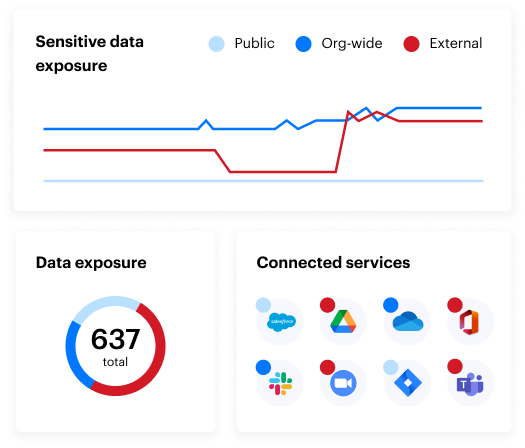The stakes are high in federal government and contracting environments.
Sensitive data like Controlled Unclassified Information (CUI), export-controlled data, and classified material are tightly governed by policies like DFARS, NIST 800-171, and CMMC.
Despite this, every day, well-meaning users sidestep security policies to complete mission-critical work. These users are not malicious. They are mission-focused. But when the system gets in the way of the mission, a user always finds a way.
Real workarounds that put data at risk
Let's look at an example of a DLP policy that may block a spreadsheet from being shared in Gmail. In the federal space, that spreadsheet might contain CUI or contractor bid data subject to audit, breach reporting, and potential legal liability.
However, a user attempts to email a subcontractor with a compliance matrix for a proposal. A DLP policy flags the email due to key phrases associated with export controls.
Instead of escalating or reporting the issue, the user:
- Screenshots the file
- Sends it from a personal Gmail account
- Or uploads it to a non-compliant cloud platform
The intent? Keep the project moving.
The result? A potential CUI spill, ITAR violation, or breach of DFARS 252.204-7012.
Labeling fatigue in CUI environments
Manual labeling systems prompt users to mark every file with a sensitivity label. In theory, this should ensure that data is handled according to classification rules. But in practice:
- Users can default to "Unclassified" or "Public" to bypass enforcement
- Labels can be applied inconsistently or incorrectly
- Files could be spread across shared drives or unmanaged devices
This erodes the value of security controls and breaks audit trails needed for CMMC certification.
Why users bypass security in federal workflows
As mentioned previously, the intent behind bypassing security measures isn't always malicious. A few reasons security gets bypassed include:
- Mission always comes first: Federal teams operate under tight timelines, grants, procurements, proposal deadlines, and real-world consequences.
- Overreaching policies: Broad or poorly tuned DLP rules can block legitimate work, creating daily friction.
- Lack of awareness: Even with training, many users don’t fully grasp the sensitivity of data they’re handling.
- Shadow IT culture: When official systems are slow or too restrictive, users turn to personal accounts, thumb drives, or consumer tools.
Security isn’t just a technical issue. It’s a human behavior issue, especially in high-pressure, high-stakes environments.

How to improve security without hindering the mission
Here are steps security teams can take to keep security best practices consistent and strong, without interrupting daily operations.
Automate classification at the source
Don’t rely on users to label CUI or ITAR data correctly. AI-powered tools can scan documents, understand context (contracts, program names, technical specs), and apply consistent labels without relying on human judgment.
Tune DLP policies to avoid collateral damage
Overly aggressive DLP settings that flag everything slow down users and invite workarounds. Refine policies using actual content patterns, past incidents, and role-specific context. Precision beats paranoia.
Use behavior analytics to spot risky workarounds
Track user behavior, not just content. Did a user who normally works 9–5 suddenly upload 10GB of data at 2 a.m.? Are files being renamed or zipped to avoid detection? These are signals of risky patterns, not just policy violations.
Build security into productivity tools
If collaboration platforms are hard to use or restrict access by default, users will seek alternatives. Enable secure sharing tools with built-in auditing, labeling, and encryption so the path of least resistance is also the safest.
Security isn’t about control — it's about context
In government environments, we often think of compliance as a checklist. But that usually misses the point. A security policy that isn’t aligned with how people actually work is just a suggestion, and one that users will bypass if it prevents them from delivering results.
The future of secure federal contracting doesn’t rely on blocking users.
It relies on understanding them, predicting their behaviors, and automating protection in the background.
Stop relying on users to get security right
When the mission is on the line, a user will always find a way around the process, past the policy, through the cracks. Not because they want to break the rules, but because they need to get the job done.
To protect sensitive federal data:
- Make classification invisible
- Tune policies to real-world use
- Monitor behaviors, not just documents
- Empower mission delivery without compromising security
At Varonis, our challenge isn’t stopping them — it’s securing the shortcuts they would’ve taken.
Interested in learning more? See how we can help you improve your security and speak with our Varonis Federal Team today.
What should I do now?
Below are three ways you can continue your journey to reduce data risk at your company:
Schedule a demo with us to see Varonis in action. We'll personalize the session to your org's data security needs and answer any questions.
See a sample of our Data Risk Assessment and learn the risks that could be lingering in your environment. Varonis' DRA is completely free and offers a clear path to automated remediation.
Follow us on LinkedIn, YouTube, and X (Twitter) for bite-sized insights on all things data security, including DSPM, threat detection, AI security, and more.









